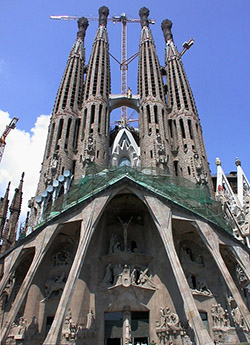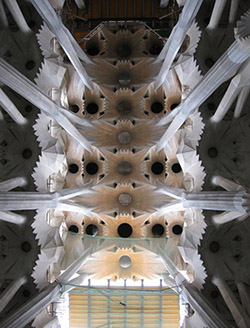
La Sagrada Familia will be consecrated on Sunday by the Pope himself
 |
Basic information about the Barcelona temple Sagrada Familia:
The monumental cathedral Sagrada Familia (Holy Family) is located in the center of the Catalan metropolis of Barcelona. It has been under construction for 128 years (about one-fifth is completed) and attracts nearly three million tourists annually.
This richly decorated basilica with five naves features three intersecting aisles and is a unique architectural work; for example, instead of supporting pillars, it uses parabolic and hyperbolic arches that create only vertical pressure, so each of the aisles maintains its balance. The remaining pressure is eliminated by the sloping of certain columns, which branch like tree crowns.
When the temple is completed (around 2026, coinciding with the centennial of its creator Antonio Gaudí's death), it will have 18 towers, the tallest measuring 170 meters, thus surpassing the current tallest cathedral in the world in Ulm, Germany (161.5 meters).
The entire cathedral depicts the life of Jesus Christ and biblical history. Of the 18 towers, 12 are dedicated to the apostles, four to the evangelists, one to Mary, and the tallest to Christ. The three façades illustrate the birth of Jesus, his passion and death, and human life in the process of creation.
The third, main façade (Fachada de la Gloria), for which construction has yet to begin, will face south and is meant to depict sins and virtues, heaven and hell, life and death. Gaudí himself outlined it only generally: "I decided to leave it for the next generation to complete, so they too could contribute to the temple."
 |
The foundation stone of the cathedral was laid on March 19, 1882. Construction began according to the design of architect Francisko de Paula del Villar, but at the end of 1883, Antonio Gaudí took over the work. After his death in 1926, construction continued based on his designs. During the Civil War (1936-1939), part of the structure was destroyed by fire, including Gaudí's plans and models, which were later restored by architect Francesc de Paula Quintana, Gaudí's former collaborator.
Even Gaudí himself did not have illusions about the completion of the magnificent cathedral. "It will only be completed by Saint Joseph,” he would say about his life's work, whose completion is complicated not only by the intrinsic challenge of the project but also by a lack of financial resources.
Catalan architect, urban planner, and innovator Antonio Gaudí y Cornet (1852-1926) was a representative of a unique style and a pioneer of Art Nouveau in Spain. He dedicated the last 16 years of his life exclusively to the construction of the Barcelona cathedral. During that time, he also neglected his appearance, so when he was struck by a tram in early June 1926, he was initially mistaken for a beggar.
Other buildings by Gaudí include whimsical houses, such as the Barcelona Casa Milá (nicknamed La Pedrera), which resembles sand dunes in both facade and color, and the colorful Casa Batlló, as well as Park Güell in Barcelona, an unfinished grand project of a garden city. Seven of Gaudí's constructions are on the UNESCO list, including the Nativity Façade and the crypt where Gaudí is buried.
The English translation is powered by AI tool. Switch to Czech to view the original text source.
0 comments
add comment
Related articles
0
09.12.2021 | In Barcelona, the tallest tower of the Sagrada Família basilica was ceremoniously unveiled
0
18.09.2020 | The construction of the Sagrada Família basilica was slowed down by the coronavirus
0
11.06.2019 | Sagrada Familia has received building permission after more than 130 years
0
19.10.2018 | Sagrada Familia will receive a building permit after more than 130 years
0
09.06.2016 | 90 years ago, the famous Spanish architect Antonio Gaudí passed away
0
23.09.2011 | Gaudí's Sagrada Familia will be completed by 2028 at the latest
0
07.11.2010 | The Pope consecrated Gaudí's temple La Sagrada Familia












